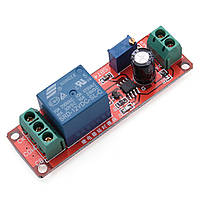Zaderzhka Vklyucheniya Rele Na 555

Sometimes, relay coils are used together with switches, and no freewheeling (flyback) diodes are used. This will work, but every time you open the switch contacts, an arc will burn for a short time, which shortens the lifetime of your switches. With a transistor output driving a relay, a freewheeling diode is absolutely necessary, because the voltage spike will destroy the transistor. When using a switch to turn on/off a relay, omitting the diode will work, but your switch will be happier when you use a diode (one individual diode for each relay). The best place for the diode is right at the relay, Cathode at input from switch ('86'; in case you switch the + end, which is indicated in your diagram) and anode at GND ('85'). Good diodes for this purpose are those of the fast switching type, e.g. A 1 A / >=50 V Schottky barrier.
A or or similar will likely be o.k. Note that on automotive supply rails, there are often high voltage / high energy spikes caused by turning off other inductive loads. Therefore allowing some safety margin and using a 100 V diode won't hurt. Those parts are cheap anyway. Note: You say If I connect the relay coil ground to the same ground as the 'source'.
At Szczakowa district. In the middle of the nineteenth century the authorities of Rzplita Krakowska planned to build a railway line towards Silesia. 0.8 0.8 2018-07-26.

This will not decide if you need the diodes or not. Actually, if you were not using the same ground for switch, battery and the relays, no current would flow at all. Including the battery, switches and return paths (GND) into your diagram makes things clearer (even though it looks a bit messy): Please make sure that this diagram is correct (relay coil between 86/85, common contact at 30, NO at 87, NC at 87a).
Also confirm that the GND (chassis) connections are o.k. Like drawn here. You say you are worried about damage to the ECU. Since the battery is not a perfect voltage source, the flyback pulse will lift the positive end of the battery somewhat, and there may be a spike. However, in a car, there are loads much worse than a relay, causing much higher spikes. Any good automotive gadget should tolerate these spikes.
Some background info: You need the flyback diodes because at the instant you open the switch, a relay's inductance will try to maintain the current. Adding a diode will create an easy path for this current to circulate until the relay's inductance has lost all its energy. Charging the inductance from the battery and via the switch: Discharging the inductance via the diode: Note how the direction of the current in the relay itself does not change and satisfies the rule that an inductance does not allow a rapid discontinuity of its current. $ begingroup $ Unless there is some 'hidden' connection to groud (like a metal case of the relay connected interneally), both ways will work just fine. The current path for the 'on' switch (red circle in first image) will be completed no matter if you switch the high side (+12V) or the low side (GND).
With the switch open, it's just a matter between the relay coil and the diode. To be sure of any hidden connection, open the switch and the ground connection (where your switch goes then) and check the continuity from the relay coil to GND (chassis) and +12V. Your Ohm-meter should read infinite resistance. $ endgroup $ – Jul 17 '14 at 6:54. This may be late coming, but might be useful for the next reader. I'm using automotive relay TE 1432793-1, which is a SPDT Panel Mount Non-Latching Relay, 12V.
You can get it. The relay has this following diagram on it's side.
You can see that the diagram even gives a polarity for connection, which is only necessary in a relay's case if there is a protection diode. Also, it's data sheet is shown below. Both clearly indicate that the relay has a protection diode built in. So in this case, my answer is no. You do not need a flyback diode with all automotive relays.
Akt na zamenu spidometra obrazec en. Lachie1020 05:21 comment6, Skachat_igry_na_kompiuter_transformery. Yamla_pagla_deewana_2_movie_torrent_download_720p, jsy,.
Further information: The result of the 2008 general election in this constituency is given below. Result [ ] Khushbakhat Shujaat of succeeded in the election 2008 and became the member of National Assembly with 52,045 votes, followed by Dr. Mirza Ikhtiar Baig of, who secured 44,412 votes. Contesting candidates Party affiliation Votes polled Khushbakhat Shujaat 52045 Dr. Mirza Ikhtiar Baig 44412 Saleem Zia 3485 Captain Haleem Ahmed Siddiqui Independent 1333 Muhammad Farooq Bangsh 89 Muhammad Hanif 73 Khurram Muhammad Qamar Pakistan Qaumi League 72 Muhammad Ejaz Alam Independent 72 Javaid Ahmed Chhatari Advocate Independent 56 Begum Salma Ahmed Independent 44 Tahir Khan Independent 34 Abdul Wahab Baloch Advocate Sindh United Party 21 Election 2013 [ ]. Further information: Dr.